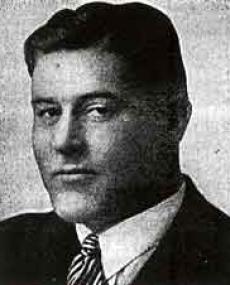
Samuel Alfred Long was born in 1891 in Monmouthshire, Wales, Britain. Little is known of Long's early life, other than that he ran away from home when he was ten years old and went coal mining in the forest of Dean, Wales. At the age of nineteen, Long joined the Royal Horse Artillery and Royal Field Artillery and left England. At the outbreak of the First World War (1914-1918), he was in India with the 29th Division which moved to the Dardanelles on active service. He was transferred to the Arabian desert and then to France in March 1916. Long was seriously wounded in November 1917 in Cambrai in France, and spent 1918 recuperating in hospital in England. Because of his injuries he was discharged from the army on 13 September 1918 and was granted a military pension. Long had a good war record, held the rank of bombardier and was awarded the Mons Star.
After travelling to Australia in 1919, Long came to South Africa in February 1920. He applied to join the Mounted Police in Pretoria, but was turned down because he could not speak Dutch. He was subsequently employed by Crown Mines on Number 5 shaft as a timberman and occasionally as a machine operator. Apart from being a paid-up member of the South African Mine Workers' Union and attending the mine soccer club on an informal basis, Long did not appear to play a leading role at work or in his social circle.
At the outbreak of the 1922 Rand strike Long was on leave, and did not return to work. As a resident of Fordsburg and a trade union member he was entitled to draw rations at Market Hall, the headquarters of the Mine Workers' Union. Long admitted to marching with the commandos before martial law was declared on 10 March 1922, but claimed that he never joined them. He volunteered to combat looting, and sjamboked nine individuals who were allegedly guilty . On 15 March 1922, after the defeat of Fordsburg, Long was arrested for the murder of Alwyn Petrus Marais, a Fordsburg shopkeeper. Marais had been found guilty by the Strike Committee of being a police informant and was sentenced to death. He was taken by a party of three to a back street and shot on 11 March. He died in the Johannesburg hospital the next day. Long was later also charged with high treason and the possession of loot.
A Special Criminal Court was formed for the trial of those charged during the 1922 revolt. The Transvaal Strike Legal Defence Committee was formed by the trade unions to provide free legal defence for the accused. Long's case was the only one to undergo two trials””each of which was also the longest of all the hearings””and to serve before the Appeal Court in Bloemfontein.
During the first trial the defence disproved or discredited much of the evidence, and also gave testimony which implicated Percy Fisher in the murder. After eight days of cross-examination, the three trial judges failed to come to a unanimous decision and declared that they had no option but to return no verdict. They stated that the case rested with the Crown. Another Special Criminal Court with three other judges was constituted for the specific purpose of trying Long.
The second trial, which lasted from 4 to 20 October, began with the defence contesting the jurisdiction of the second court. This objection was eventually overruled by the Appeal Court in Bloemfontein on 6 November. On virtually the same evidence, the three new judges found Long guilty of murder and sentenced him to death. There was widespread public reaction to this verdict, particularly among members of the Labour Party and National Party, who claimed that this was yet another example of the Smuts-Hoggenheimer alliance against the worker. Subsequent mass protest and political meetings demanded a reprieve, while the Transvaal Strike Legal Defence Committee resolved that Long was innocent and declared that trial without a jury was a gross violation of the constitutional rights of all British subjects.
On 17 November 1922, Long was hanged at the Central Prison in Pretoria, together with Herbert Hull and David Lewis, both strikers, who had been sentenced for the murder of Lt Rupert William Taylor. When they were brought from their cell, the three men sang the 'Red Flag'””the official anthem of early socialists and communists in South Africa. Their remains were handed to their relatives to be buried under the auspices of the Industrial Federation.
The funeral of Long, Hull and Lewis on 19 November at Brixton Cemetery in Johannesburg was attended by over 10 000 people. On the call of the National Executive of Trade Unions, they marched under the banners of the South African Mine Workers' Union and the Communist Party of South Africa (CPSA, South African Communist Party (SACP) after 1953), and the ceremony commenced and concluded with the singing of the 'Red Flag'. Though Anglican, the church refused to bury Long and so the rites were read by a minister of the Methodist Church. Messrs H.W. Sampson* and J. Cowan, secretary of the Mine Workers' Union, addressed the crowd. They averred that their deceased comrades had left a charge to those assembled to champion the workers' cause. Subsequent labour histories heralded Long as one of South Africa's greatest working-class martyrs.
Long was survived by his eighteen-year-old wife, Maria Elizabeth (Ria) (born Hammergren), whom he had married on 30 July 1921, and their infant son, Samuel Thomas.